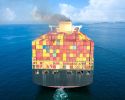Ammonia winning shipping’s future fuel race

Ammonia accounts for 45 percent of the world's marine fuel in 2050. This is predicted by the International Energy Agency (IEA) in its report World Energy Outlook 2022. But this requires an ambitious climate policy.
The world is in its first global energy crisis. This is how the IEA describes the critical situation caused by Russia's invasion of Ukraine. The invasion has cut off the supply of oil and gas from Russia, driving up the price of gas in particular to modern highs. This in turn has created a cost pressure on electricity and skyrocketing energy costs have caused many countries to increase the production of oil or coal-based electricity.
But the crisis has also led to new investments in renewable energy and, according to the IEA, the crisis could lead to an acceleration of the transition to fossil-free energy sources. For the first time, the IEA's analysts see, for example, that the demand for fossil fuel in the world will reach its peak within 15 years. But the transition is still too slow, and if the 2-degree target is to be reached, the world's governments must adopt a much more ambitious climate policy.
The 525-page long report is not a quick read but contains a lot of data which will hav major implications on shipping. The report reasons on the basis of three scenarios, and in the most ambitious (with a goal of net zero by 2050), the fuel mix for shipping will undergo a major transformation that will reduce its global carbon dioxide emissions from today's 840 million tonnes to 110 million tonnes by 2050. Progress depends on development of several new fossil-free fuels, but above all on ammonia, which is believed to cover 45 percent of the world's need for maritime fuel. Bioenergy and hydrogen will each cover a further 20% of demand, with hydrogen mainly used on short and medium distances. Electricity plays a smaller role in the context and will be used above all on smaller ferries that travel short distances.
Energy-saving measures such as rotorsails can also play an important role in shipping, the IEA points out, as they "help" reduce the need for all types of fuel.
So do we get rid of the oil? No Unfortunately not. As ships have a life span of 20-35, the IEA believes that oil will still make up almost 15% of shipping's fuel needs in 2050. Although converting ships to fossil-free fuels is possible, it will require major investment and coordinated efforts among fuel suppliers, ports, shipyards and shippers, especially in the case of large transoceanic vessels, writes the IEA.
-
 NextWave – en podd som ska locka unga
NextWave – en podd som ska locka unga -
 Ny studie: Eldrivna pendelbåtar kan effektivisera Stockholms kollektivtrafik
Ny studie: Eldrivna pendelbåtar kan effektivisera Stockholms kollektivtrafik -
 Sjöfartens utsläpp ökar
Sjöfartens utsläpp ökar -
 Sociala relationer påverkar val av bränsle
Sociala relationer påverkar val av bränsle -
 Sjöfartens omställning kräver ”mjukare” påtryckningar
Sjöfartens omställning kräver ”mjukare” påtryckningar -
 Hon hade avtalad tid med Kapten ynkrygg
Hon hade avtalad tid med Kapten ynkrygg -
 Lighthouse omvärldsanalys 2025 – osäkerhet och tullar präglar sjöfarten
Lighthouse omvärldsanalys 2025 – osäkerhet och tullar präglar sjöfarten -
 Se seminariet Shipping in the Marine Environment
Se seminariet Shipping in the Marine Environment -
 Vad betyder egentligen de 90 procenten?
Vad betyder egentligen de 90 procenten? -
 Hålla där...
Hålla där...

